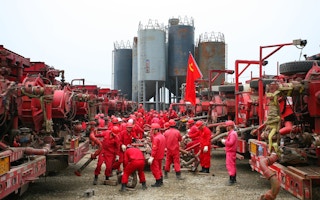Companies such as Royal Dutch Shell Plc and China National Petroleum Corp. are starting to drill for gas and oil in shale rock in Sichuan, the nation’s most seismically active province, a process geologists say raises the risk of triggering quakes.
“For the Sichuan basin, earthquakes are a problem for shale gas and shale oil production because of the tectonic conditions,” said Shu Jiang, a professor at the University of Utah’s Energy & Geoscience Institute in Salt Lake City. “The siting of the wells could cause some artificial earthquakes.”
China’s shale gas reserves may be almost double those of the U.S., where unlocking the commodity slashed energy costs, reduced imports and raised the prospect of energy independence.
The U.S. shale boom may add as much as $690 billion a year to GDP and create 1.7 million jobs by 2020, according to a study by McKinsey & Co. For China, emulating the U.S. would provide greater energy security and help curtail dependence on burning coal that blankets cities in smog.
“Once they crack the code on shale, they’ll want to push aggressively on it,” said Neil Beveridge, an analyst at Sanford C. Bernstein & Co., referring to geological and regulatory issues surrounding development.
Heavily faulted
A key step in producing shale gas is hydraulic fracturing, or fracking, where millions of gallons of pressurized water, chemicals and sand are injected underground to shatter rock and release trapped gas. Afterward, some of the liquids return to the surface and often are disposed of in underground wells.
Disposal of waste fluid has been linked to quakes in the U.S. and China.
Sichuan lies at the crossroads of some of the earth’s most active fault lines.
“The Sichuan basin is at the edge of the biggest continental collision in the world, India smashing into Asia,” said Julio Friedmann, chief energy technologist at the Lawrence Livermore National Laboratory and former research scientist at Exxon Mobil Corp. “That’s stressing the continental crust.”
More than 2,700 quakes of varying magnitude were recorded around an underground injection well in Zigong, Sichuan, during a three-and-a-half year study by the Earthquake Administration Bureaux of Sichuan, Hebei and Zigong Municipality.
“With the beginning of increased water-pressure injection, seismic activity around the test well showed a significant increase,” researchers led by Zhang Zhiwei wrote in a 2012 paper.
Fracking was linked to minor earthquakes near Blackpool, England. The U.K. placed a moratorium on the process for 18 months to assess the well. Drilling resumed in December.
Since 2000, a flurry of mostly small, yet unusual temblors were recorded in the central part of the U.S., prompting the Department of the Interior to commission a study of the events in Oklahoma, Texas, Colorado, Ohio and Arkansas.
Wastewater wells
The investigation by the U.S. Geological Survey did not suggest that fracking was causing the increase in quakes, though noted: “USGS scientists have found, however, that at some locations the increase in seismicity coincides with the injection of wastewater in deep disposal wells.”
While most induced temblors are not strong enough to be felt on the surface, a 5.7-magnitude earthquake linked to a disposal well in November 2011 in Oklahoma knocked down 14 homes and injured two people. Sichuan is almost eight times more densely populated than Oklahoma.
A 2008 earthquake in Wenchuan, Sichuan, the most powerful in China in more than a decade, killed 69,227 people, including 5,335 schoolchildren, after thousands of classrooms crumbled. China is home to three of the 10 deadliest earthquakes of all time, according to the U.S. Geological Survey.
Induced earthquakes
“Anytime you’re going into an area that’s more heavily faulted, the risk is higher that you could cause induced earthquakes,” said Briana Mordick, a staff scientist at the Natural Resource Defense Council and former geologist at Anadarko Petroleum Corp. (APC) “Sichuan is definitely a concern.”
Mordick said calculating seismic risk from tectonic stress is not simple.
Southwest China, which includes Sichuan, and the Upper Yangzi area account for 40 percent of the country’s shale gas reserves, according to the Ministry of Land and Resources. China aims to produce 6.5 billion cubic meters of shale gas by 2015 and as much as 100 billion cubic meters by 2020, from zero output this year. Current regulations don’t require earthquake surveys as part of the standard environmental impact assessment.
The Ministry, which regulates the oil and gas industry, didn’t respond to calls and faxes seeking clarity on rules governing seismic studies before drilling.
Pre-drill analysis
“We do detailed structural analysis as routine part of our pre-drill evaluation,” Shi Jiangtao, a Shell spokesman in Beijing, said in an e-mail. “This means that we evaluate the geology by using seismic, surface geology, nearby well data, etc.”
Shell, which plans to invest $1 billion a year in China’s shale gas industry, declined to comment directly on earthquake hazards in Sichuan. China National Petroleum, Shell’s partner, didn’t respond to an e-mailed list of questions. China Petrochemical Corp., which is also drilling in the area, didn’t respond to calls and e-mails seeking comment.










